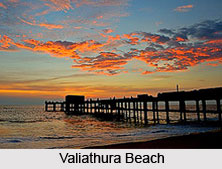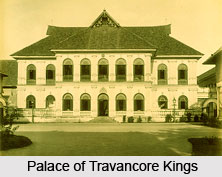 Valiathura is a suburb of Thiruvananthapuram, which is the capital of Kerala, "God"s Own Country". This was once the only port along the South Kerala coast. In the later half of middle age and early modern age, Valiathura acted as one of the busiest port of South India. When Kochi became the prominent port in Kerala, Valiyathura lost its significance as a major port. Now Valiathura is considered as a fishing port.
Valiathura is a suburb of Thiruvananthapuram, which is the capital of Kerala, "God"s Own Country". This was once the only port along the South Kerala coast. In the later half of middle age and early modern age, Valiathura acted as one of the busiest port of South India. When Kochi became the prominent port in Kerala, Valiyathura lost its significance as a major port. Now Valiathura is considered as a fishing port.
Location of Valiathura
Valiathura is located near Shankhumugham Beach. It is a typical coastal region. The vegetation consists mainly of coconut trees. The land is higher in Valiathura, so calamities due to the monsoon tides are less compared to the other nearby coastal regions of Kerala.
History of Valiathura
Valiathura also spelt as Valiyathura was known as Raithura or Rajathura. It was known from the time of Travancore Kingdom in the middle ages. From the time of King Solomon, Valiyathura port was active and used to export spices from India. The Saint Antony`s Cathedral is a Catholic Church that has the history of more than 500 years and the New Year day celebration started more than 120 years ago. At the battle between Marthanda Varma and Ettuveetil Pillai, one of the Pillai and his soldiers were protected by the fisher people of Valiyathura and some of those people married a few Valiyathura girls and settled in Valiyathura.
 Tourism in Valiathura
Tourism in Valiathura
Valiathura is a place of historical heritages and the natural beauty. The age old pier, St. Antony"s Forane Church and the Valiathura Beach are the centre of attraction to the national and international visitors. Other tourist sites are Shangumugham Beach and Beemapally mosque.
Pier of Valiathura
Valiathura is famous for its pier. The pier is a raised construction, including bridge and building supports and walkways, typically supported by widely spread piles or pillars. The lighter structure of a pier allows tides and currents to flow almost unhindered, whereas the more solid foundations of a quay or the closely spaced piles of a wharf can act as a breakwater, and are consequently more liable to silting.
The pier is the cynosure in Valiathura Beach to the visitors. The 51-year-old, 703-foot pier and the godowns behind it are a far cry from the past, when up to 50 cargo ships used to call here at a time. Opened in 1956, it was the only port along the South Kerala coast.
St. Antony"s Forane Church
St. Antony"s Forane Church in Valiathura was established in 1530 by the Franciscan Missionaries. In 13th century, Pope Innocent IV sent a few Franciscan and Dominican missionaries to Kollam, Mampally and Valiathura to proclaim the Gospel of Christ.
Visiting Information
Valiathura is 5 km from the city centre. The privately owned and KSRTC buses ply from East Fort. Auto rickshaws can also be hired. A bypass of National Highway 47 passes 1 km to the east of Valiathura. The nearest railway station is Thiruvananthapuram Central, around 8 km away.



















